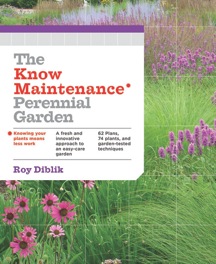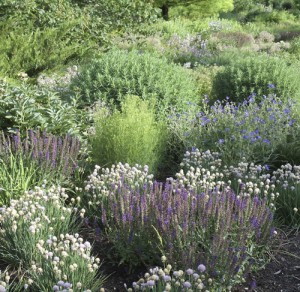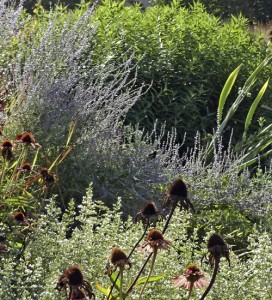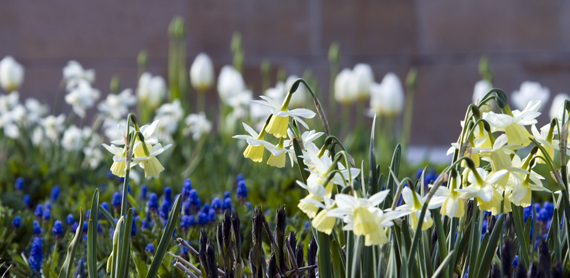The Know Maintenance Perennial Garden: An Interview with Author Roy Diblik
Posted in Shop/Book Reviews on April 2 2014, by Joyce Newman
Joyce H. Newman holds a Certificate in Horticulture from The New York Botanical Garden and has been a Tour Guide for over seven years. She is a blogger for Garden Variety News and the former editor of Consumer Reports GreenerChoices.org.

Roy Diblik’s new book, The Know Maintenance Perennial Garden, out this month from Timber Press ($24.95 paperback) and available in NYBG’s Shop in the Garden, is a veritable goldmine for gardeners dreaming of lush, low-maintenance planting designs. The book provides dozens of fresh, detailed plans and gorgeous color photographs of easy-care, yet highly artistic, gardens.
Diblik is a designer and nurseryman best known for supplying the extraordinary perennials—around 26,000 plants in all—for Dutch designer Piet Oudolf’s inspiring Lurie Garden at Millennium Park in downtown Chicago. Diblik actually grew many of the plants and helped with the layout and design. He has more than 35 years of experience as co-owner of Northwind Perennial Farm located in the rolling hills of southeastern Wisconsin.
The book contains 62 garden plans laid out in color-coded grids. Many of the plans express themes, Diblik notes, that are “loosely inspired by the colors, compositions, and emotions” of Impressionist paintings by Cezanne, Monet, and Van Gogh, among others. Some plans replicate Piet Oudolf’s pioneering use of grasses for The High Line in New York City, and others recreate the dynamic plantings at England’s Great Dixter garden in Sussex.
 Designed for sunny locations as well as the shade, the plans give all the necessary details on each of the plants you will need, where to place them, and how to water and weed for best results. Each plan is designed to fill a modest 10- by 14-foot space, and they are modular, so you can rearrange them like building blocks.
Designed for sunny locations as well as the shade, the plans give all the necessary details on each of the plants you will need, where to place them, and how to water and weed for best results. Each plan is designed to fill a modest 10- by 14-foot space, and they are modular, so you can rearrange them like building blocks.
The perennials selected by Diblik are “proven successful” for regions across the northern half of the U.S., north into Minnesota, east into New York, west into Iowa and south into Missouri—the regions Diblik knows best. Over time, these plants will form what Diblik calls “plant communities,” by which he means “plants positioned to live well together with respect to their common needs and individual lifestyles, and in keeping with the maintenance capabilities and goals of the gardener.”
A special chapter at the end of the book profiles nine exceptional gardeners whose work Diblik singles out for praise, showcasing their beautiful plantings and designs.
Diblik recently explained his goals for the book and his experiences as a designer/gardener.
Q. What most appeals to you about perennials?
A. I enjoy perennials because of their lifestyle. Most have a giving nature, they are adaptable to many conditions, are actually easy to grow and care for, and I enjoy learning where they live and flourish in their native locations.
Perennials offer tremendous diversity, having many types of flowers, color, foliage, stems, and roots. They also have beautiful growth habits and structural forms. To me they are living art and a simple indication of the diversity of earth.
Q. I love the different artists’ palettes and paintings that inspire many of the plans. Why did you choose these paintings?
A. I used the impressionistic artists to provide inspiration for myself. I made plant lists relating to the tonal changes of color in the paintings and also used the flow of the colors to influence the percentage of certain plants grouped together. I used the plant lists to create the patterns in the designs, knitting everything together with short grasses and sedges. For me there is a connected feeling between the artists, their work, and the gardens I create.
Q. Your tagline for the book is: “Knowing your plants means less work.” Is that your main message?
A. There is so much confusion about buying and placing plants. Plants are purchased based on initial appearance and generally placed together based on bloom time and flower color. Many are short-lived, fashionable plants that decline quickly in average garden conditions and then are frequently replaced. I believe if we take time to come to “know” plants as we do our friends, we can create healthier relationships—plants with plants, plants with people, and people with people.
Q. How did you go about “testing” the plant combinations?
A. I designed each one based on an impressionistic painting or places I have visited and read about. I have been growing these plants in the ground since 1978, so I know them well and have used many of the patterns and combinations to create different mixtures. With just a few, you can create continuous patterns. The plans and patterns can be cut in thirds, curved, and one style blended with another. The plants can be spaced differently, or you can leave a few out. And vegetables can be placed within the planting.
 Q. What are you working on now?
Q. What are you working on now?
A. I am growing common native, European, and Asian sedge (Carex) to use as ground layer plantings under trees and shrubs to take the place of wood mulch. The idea is to create living mulch, mow the sedge once a year, and incorporate more plants within the sedge when there’s time and money. So I’m trying to create enhanced gardening practices. It’s difficult to put a healthy garden in at one sitting and many times it’s not healthy for the future development of the planting.
Right now we need to know as much as we can about the native shortbeak sedge (Carex brevior), then share all the ways we can create and design with this plant and others.
Q. In your preface to the book, you mention planting kohlrabi with your grandma as a child. Do you think a child’s introduction to gardening—like your own—is important for cultivating future gardening interests?
A. I think gardening with children is as important as math, science, and all computer skills. To have a sense of nurturing plants and their relationships to each other, the soil, rain, sun, and people promotes all the other forms of knowledge that relate to a person. Humans are not the only daily contacts we require. It’s in our genes to relate to other living beings.
Q. You met Piet Oudolf in the summer of 2001. How did your partnership work on the Lurie Garden project?
A. He contacted me through a mutual friend, letting me know he wanted to meet and discuss the Millennium Park project in Chicago. He came out to Northwind and knew we could work together because our farm reminded him of his own place in the Netherlands. As a person he is thoughtful, inquisitive, sensitive and sharing. He’s a friend to all he meets. Piet is good at what he does because he’s continuously focused on his style and process and understands the current history of ecology-based gardening.
For the Millennium Park project, I was responsible for growing many of the plants and lining up other growers to supply the 26,000 plants for the garden. I also helped him lay out the plants and guided the contractor in planting.
 Q. Do the outstanding gardeners/designers that you profile in the book share a common approach?
Q. Do the outstanding gardeners/designers that you profile in the book share a common approach?
A. The nine people in the last chapter are practicing planting at a high level. They are concerned not only with the thoughtful use of plants, but with designed relationships—with involving, educating, and engaging people. Their gardens and practices are integrated into community lifestyles. The open spaces that they develop often teach visitors or passersby that beauty is continually an engaging element for all of us.
Photographs taken from The Know Maintenance Perennial Garden© Copyright 2014 by Roy Diblik. Published by Timber Press, Portland, OR. Used by permission of the publisher. All rights reserved.


